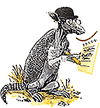
Question by Frontier Reporter, May 15, 1871:

Well, I'll be....here's a scoop! That looks like the famous Civil War officer, General Sherman, in the back of that wagon! Sir, sir! What brings you all the way here to Fort Griffin on the Texas frontier?
General William Tecumseh Sherman answers:
I am here on official business. I am General William Tecumseh Sherman, the commanding General of the United States Army. I am here to inspect the frontier forts. In the past few months, both the Congress and the War Department have been bombarded with angry letters, petititions, and memorials from Texas politicians and citizens. According to these reports, Comanche and Kiowa Indians continue to raid throughout the West Texas frontier, robbing and murdering with wild abandon, despite the presence of U.S. soldiers.
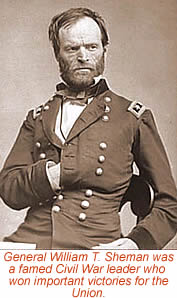
The insults against the Army and its Indian Policy have become so loud and so continuous of late that I have made this personal trip from Washington to investigate. In this way, I will be able to learn the facts myself and see if there is indeed cause for alarm.
I am accompanied by my staff, a light escort of soldiers from the Tenth Cavalry, and Inspector General R. B. Marcy. Our journey began in San Antonio on May 2. Since departing the Alamo City on that date, we have proceeded in a northerly fashion, visiting Forts Mason, McKavett, Concho, Chadbourne, and Phantom Hill, before stopping here at Fort Griffin for two days.
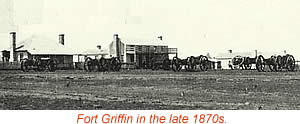
Upon my arrival here, I was met by a mob of outraged settlers. They recounted yet more tales of Indian incursions onto their land. They demanded that I assign more soldiers to Fort Griffin to protect their property and homes. My attempts to calm their fears were made in vain.
Although my tour of inspection is not yet complete, I have already formed an opinion on the matter in question. I have come to believe that these reports of Indian atrocities are exaggerated-greatly exaggerated. True, as General Marcy pointed out, the frontier is much depopulated. We passed many deserted cabins along our way here. General Marcy faults the Indians.

I disagree. The settlers simply moved for lack of water. I have seen not a trace of an Indian thus far to persuade me otherwise. I am convinced that whatever Indians do cross the Red River enter Texas only to steal horses.
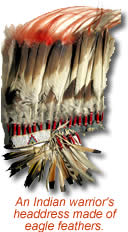
This frontier is a peaceful one. I am confident in this knowledge. If the situation was truly perilous, why would I put my own valuable scalp at risk? If the Indians were indeed patrolling the trail, they would have surely spied our stately entourage by now and attacked. Yet we have not seen even one moccasin track. If I were the least bit concerned about the safety of this area, would I travel along in a clumsy wagon with only a handful of men to protect me? Absolutely not. If my life were in danger, I would want a swift horse for the chase and a huge body of armed men to cover me.
At this time, I see no reason to recommend any further addition of soldiers to the frontier defense or a change of our Indian policy. In time, the Indian problem will resolve itself and settlers will flood into this area. Texas has a very agreeable climate and I believe, one day, will enjoy great prosperity.
Tomorrow we depart for our last Texas post, Fort Richardson.
Sherman's Narrow Escape on the Texas Frontier
Gen. Sherman made it safely to Fort Richardson, but the north Texas frontier was far from safe. A few days after Sherman passed by, a war party of Kiowa Indians attacked a wagon train on the same road. The Kiowas, led by Chiefs Sanatanta, Satanka, and Big Tree, had watched Sherman and his escort pass but chose not to attack him. Their assault on the wagon train, which resulted in the brutal death of the wagon master and six teamsters, is known as the Warren Wagon Train massacre. Sherman ordered Col. Ranald Mackenzie to puruse the Indians across the Red River and capture them on their reservation in Indian Territory. With this action, the U.S. Army changed it's attitude to frontier defense, and began an all-out assault on the raiding Indians.
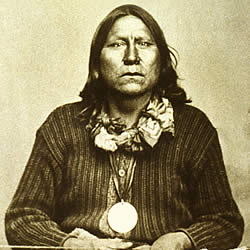 |
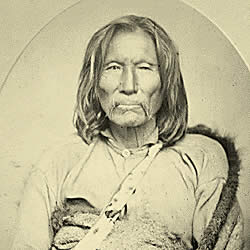 |
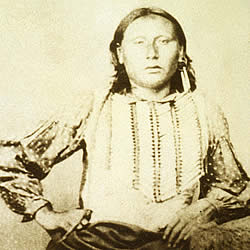 |
Kiowa leaders Santanta, Satank, and Big Tree. The Kiowas chose not to attack General Sherman, but killed 7 members of a wagon train passing on the same road a few days later.

A Famous General
William Tecumseh Sherman, one of the most famous generals in the Civil War, served as commander of the Union forces in many southern states. He led the capture of the important southern cities of Atlanta, Savannah, and Charleston, South Carolina. After Atlanta surrendered, Sherman tried to further break the morale of the southern people. "I can make Georgia howl," he stated. He sent more than 60,000 troops in a "march to the sea," with orders to destroy anything and everything that might help the Confederate forces. Sherman was one of many famous generals who spent time in Texas. Before the Civil War, Robert E. Lee, John Bell Hood, and Phillip Sheridan fought in the Indian Wars on the Texas frontier.
Credits and sources: Character dialogue by Lisa Waller Rogers; top painting by Charles Shaw; photo of Fort Griffin in 1870s courtesy Lawrence Jones, III; photo of Indian headdress by Jeff Indeck, Panhandle Plains Museum; photo of Satanta, and Kiowa ledger drawings courtesy National Anthropological Archives, Smithsonian Institution; photo of Satank, courtesy National Archives.<
